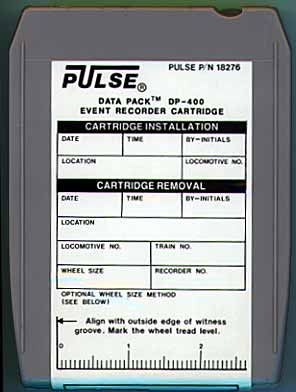

From Mike Stevens 16 Dec 2000
The tape slid into a recorder like any 8-track player, and then was locked into a box - the recorder was in a cabinet outside the cab of the engine. Trainmasters had the keys to the lock and the tapes were pulled and cataloged over time and then rewritten to after so many days. The Federal Railroad Administration has rules about how long they have to be held, etc. However, I would be surprised if the same method was used to day.
The tapes recorded speed, braking effort, throttle position, various electrical signals from the locomotive etc. The wheel markings have to be accurate to interpolate the tape data. This info is used for after-accident investigation much like the black box on an airplane, as you know by now.
They are also used to gauge safety measures in relation to train handling, motive effort, and known speed limits. For example, if an engineer pulls a train apart and causes a derailment the tape will show the motive effort of the generator relative to the throttle position that would cause a train to to be pulled apart, braked in emergency and run back together again causing a derailment.
From: "sutty" <tagaro@coventry93.freeserve.co.uk
Date: Sat, 28 Oct 2000
HELLO, I JUST THOUGHT I WOULD MENTION THAT I RECENTLY SAW A DOCUMENTARY ABOUT RAIL CRASHES IN WHICH AN 8-TRACK WAS USED TO RECORD DATA FROM THE CAB OF AN ENGINE ("DERAIL, WHY TRAINS CRASH", CHANNEL 4, UK)
REGARDS TAGARO.
FROM: Bear Chatterton 10/2000
RE: The Pulse data pack event recorder. I have never seen one, but I think I have
some correct deductions about it. So let us continue now, my dear Watson...
first, Event recorders are used wildly in Manufacturing. Every thing from room
temperatures to machine speeds are recorded. Most times in manufacturing, these recorders
are used to check Cycle times to make sure the machine is working correctly or, more
covertly, they are used to make sure that the operators are pushing the right buttons in
the proper time intervals (keeping the machine running at optimum output).
I am in quite a cynical mood today, so I think this recorder was used for the later
reason. It probably recorded the Train's rpm and speed to make sure the (train) engineer
was doing his job without any monkeying around. This would also probably serve as a
rather delicate "black box", along the same lines as airplanes use.
Second, the more ponderous markings... the Tread Level and Wheel Diameter. Let's
attack this one with the notion that metal on metal contact will cause one piece to wear.
Simple? The first piece of metal would be the Train Track and the second is the Train's
Wheels. Now if we know one piece will slowly wear, it makes a lot more sense to make the
Train's Wheels out of a slightly softer metal. By doing this, the wheel will take the
punishment and wear not the track. Besides it is a lot easier to change a wheel than
replace X hundred/thousand/million miles of train track.
O.K. We can deduce that the Train's wheels need to be tracked for wear so we know when to
replace them. Now, why only track one wheel? Reasonably simple... sorta. Either, A. They
assume that the train's weight is reasonably well distributed, so all the wheels wear at
the same rate... or B. They have already figured out which wheel takes the most abuse and
marked that wheel for measurement.
Now let's tie up some loose ends. Wheel Diameter: the back of the cartridge has a scale
from 36 to 41, references a witness mark and states that wheel diameter is in 1/8"
increments. Since I don't have a cartridge in front of me I'll assume each numbered mark
is a 1/8" apart. The 36 then becomes 36/8" or 4.5". (Top heavy fractions
are not that odd, dirty little un-scientific people like carpenters use them all the time)
The witness line would then be a circle on the wheel with a 4.5" radius. If we assume
that the wheel is only as large as the biggest number on the scale, the wheel has a radius
41/8" or 5 1/8". That makes for a 10 1/4" diameter wheel, and that sounds
perfectly reasonable.
Tread Level: I know, you're probably saying, "But, wait trains don't
have treads on those nice shiny 10 1/4" diameter metal wheels!" Well you're
wrong. Plain and simple. You are w-r-o-n-g! Trains don't have treads like cars, but they
do have treads. I believe the tread which they are referring is in fact the inside edge of
the Train Wheel. This would be a VERY important thing to keep an eye on! This is the only
piece of metal that directs the train down the tracks. If you can't think of what I'm
talking about try and remember that train set you had (or should have had) as a kid. The
toy-train's wheels had a thin extension on the inside edge that made them very hard to
center on the track and kept the train on the track in corners. The witness groove on this
scale would be something similar as mentioned above.
There. Done. Q.E.D.! All's well that ends well.
I hope you learned something today, you whipper-snapper!
Enjoy!
(a very bored at work) BEAR